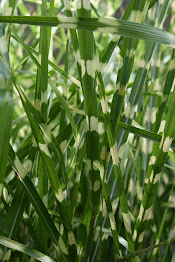Native switchgrasses (Panicums) grow four to five feet tall and have airy, fine textured seedheads. Red foliaged ones include ‘Rehbraun’ and ‘Warrior’ while bluish foliage types include ‘Dallas Blues’ and ‘Prairie Sky.’ Blue fescues (Festuca species) make cute, spiny-looking clumps growing to about 12 inches, perfect for the front of a hot, dry border. Mine, in fact, refuse to grow in the garden soil but have moved into the gravel driveway, where they actually don’t mind getting run over occasionally in exchange for the sharp drainage. And Indian grass (Sorgastrum nutans) is a tough native with surprisingly large, yellow flowers that appear as summer starts to slip toward fall.
Three grasses are particularly noteworthy for their display of tall stems, flowers and leaves. Karl Forster feather reed grass (Calamagrostis x acutiflora) grows a low grassy skirt, then shoots narrow vertical beige flower stalks three feet in the air. Tall purple moor grass (Molinia caerulea) makes a similar short skirt, then pops delicate flower stems in every direction, looking rather like a firework, up to eight feet high. It looks best with a wall, fence or evergreens as a backdrop, or positioned to catch the setting sun.
Carex ‘Blue Zinger’ is only the greenest of blues at best, but is a very tough groundcover that will thrive in shade, even under a walnut tree. Flashier is ‘Ice Dance,’ which has green foliage edged in pure white and grows to about 18 inches. It also forms a weed-impenetrable mat. Fanciest is Carex siderosticha ‘Variegata,’ with fat, pointy leaves edged in white and an elegant character. It is somewhat less drought tolerant than the others but equally weed suppressive. A friend recently gave me a plant of Carex ‘Banana Boat,’ with jaunty yellow foliage, which is guaranteed to make an ornamental grass lover like me go ape.



No comments:
Post a Comment